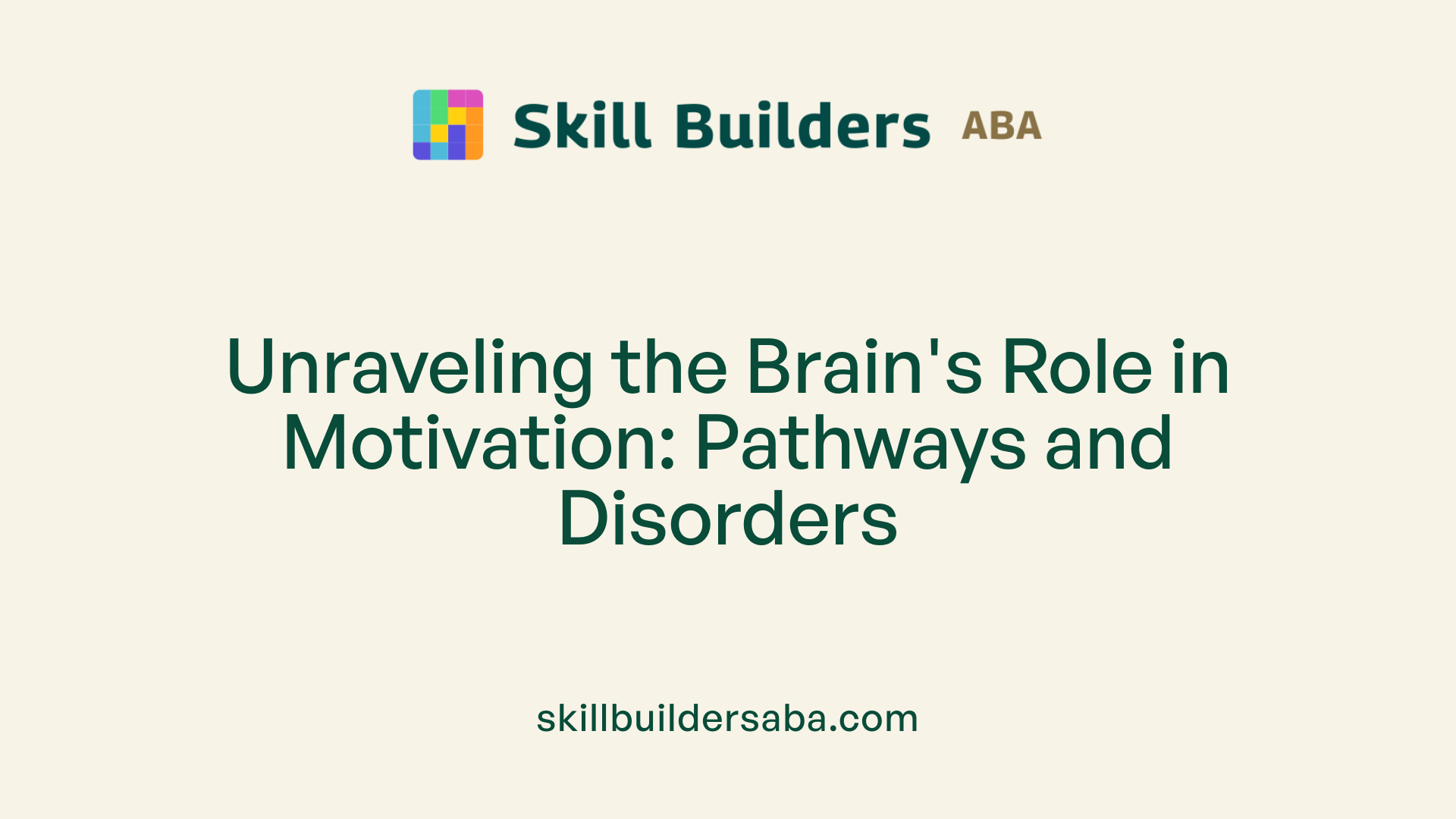The importance of motivation in behavior therapy
Harnessing Inner Drive for Lasting Change

Understanding Motivation in Behavior Therapy
Motivation functions as the engine behind human behavior, essential in initiating and sustaining efforts toward personal and psychological goals. Its role in behavior therapy is pivotal, influencing treatment engagement, adherence, and outcomes. By examining the complex neurobiological mechanisms, psychological theories, and practical strategies to enhance motivation, clinicians can significantly improve therapeutic effectiveness and foster meaningful behavioral change.
Defining Motivation and Its Psychological Foundations

What is motivation?
Motivation is the psychological force that propels individuals to initiate, persist in, and achieve goals. It involves various internal factors—such as personal interests, desires, and beliefs—as well as external influences like rewards, social recognition, and environmental pressures. These forces work together to direct behavior, sustain effort over extended periods, and influence the intensity of actions. Motivation plays a vital role across many spheres, including learning, work, health, and social interactions.
Understanding motivation is essential because it shapes decision-making and effort. It determines how much energy a person invests in tasks and how resilient they are in overcoming obstacles. Motivation varies considerably from person to person and situation to situation, depending on a mixture of biological, emotional, cognitive, and social factors. Recognizing these dynamics can help in designing effective strategies for education, therapy, employment, and personal growth.
Types of motivation: intrinsic and extrinsic
In psychology, motivation is commonly divided into two categories: intrinsic and extrinsic. Intrinsic motivation stems from internal sources. It is driven by the enjoyment, personal satisfaction, mastery, and curiosity associated with engaging in an activity. For example, someone might read a book for sheer pleasure or study a subject out of genuine interest.
Extrinsic motivation, on the other hand, is influenced by external factors. This type of motivation involves pursuing goals to obtain rewards like money, recognition, grades, or to avoid punishment. Actions motivated extrinsically are often driven by social expectations or tangible incentives.
While both types can effectively influence behavior, intrinsic motivation is generally more sustainable and associated with longer-lasting behavior change. For instance, a person who is intrinsically motivated to learn a new skill may persevere longer and experience greater satisfaction than someone motivated solely by external validation.
Biological and psychological basis of motivation
At the biological level, motivation is deeply intertwined with neural circuits, especially those involving dopamine—the brain’s primary reward neurotransmitter. The mesolimbic dopamine pathway, which includes the ventral tegmental area (VTA) and the nucleus accumbens, plays a central role in processing reward signals and reinforcing goal-directed behaviors.
When individuals anticipate or receive a rewarding stimulus, dopamine is released, which reinforces the behavior and encourages its repetition. This neural mechanism helps explain why motivational states are strongly linked to pleasure and reward experiences.
The brain regions involved extend beyond the dopamine system, including the prefrontal cortex, amygdala, and hippocampus. These areas process complex aspects such as planning, emotional responses, memory, and motivation regulation.
Psychologically, motivation is influenced by personal beliefs, self-efficacy, social support, past experiences, and environmental factors. For example, individuals with high self-efficacy—belief in their ability to succeed—are more likely to be intrinsically motivated. Conversely, negative experiences or environmental constraints can diminish motivation.
Disruptions in neural circuits or psychological processes can lead to motivational deficits, such as apathy in depression or motivational disorders like schizophrenia. Conversely, excessive activation may contribute to maladaptive behaviors such as addiction or compulsive gambling.
Overall, motivation reflects a complex interplay between biological systems and psychological processes, evolved over millions of years to optimize behavior in response to internal states and external demands. Understanding these mechanisms offers pathways for effective interventions in mental health and behavioral change.
| Aspect | Explanation | Additional Details | |---------|--------------|--------------------| | Motivation Definition | The psychological force driving goal-directed behavior | Involves biological, cognitive, emotional, and social factors | | Intrinsic Motivation | Driven by internal satisfaction and personal interest | Includes curiosity, mastery, creativity | | Extrinsic Motivation | Driven by external rewards and pressures | Includes praise, money, social recognition | | Brain Mechanisms | Neural circuits involving dopamine | VTA, nucleus accumbens, prefrontal cortex, amygdala | | Factors Influencing | Personal beliefs, environment, past experiences | Self-efficacy, social support, emotional states | | Disorders of Motivation | Apathy, addiction, schizophrenia | | Strategies to Enhance | Goal setting, supportive environment, self-efficacy | Using motivational interviewing, celebrating progress |
Understanding motivation from a multidisciplinary perspective enriches our grasp of human behavior. It highlights the importance of fostering internal drives and addressing biological and environmental barriers to support positive change and well-being.
The Dual Nature of Motivation: Intrinsic and Extrinsic

What are intrinsic and extrinsic motivations?
Motivation is a fundamental driver that pushes individuals to act towards their goals, and it can be categorized into two main types: intrinsic and extrinsic.
Intrinsic motivation is fueled by internal satisfaction. When someone is intrinsically motivated, they engage in activities simply because they enjoy, find interesting, or derive personal meaning from them. For example, reading a book for pleasure, pursuing a hobby out of genuine interest, or studying a subject out of curiosity exemplify intrinsic motivation.
Extrinsic motivation, on the other hand, is driven by external rewards or pressures. This includes working for a paycheck, studying to earn good grades, or participating in competitions for trophies or social recognition. The focus is on outcomes outside the activity itself.
Both motivation types can influence behavior significantly. While intrinsic motivation often leads to deeper engagement and persistence, extrinsic motivation can effectively initiate behavior change, especially when external rewards are aligned with personal goals. Recognizing how these motivators operate can help in designing environments that foster better engagement and sustained effort.
How does motivation relate to behavior?
Motivation acts as the energy force behind all goal-directed actions. It determines how much effort individuals put into tasks, how persistently they pursue their objectives, and the intensity of their efforts.
Different psychological perspectives shed light on this relationship. Humanistic theories emphasize intrinsic motivation driven by the desire for self-fulfillment and personal growth. Performance-centered approaches underscore motivation as a way to optimize performance by creating rewarding experiences.
At its core, motivation influences whether people start, continue, and complete behaviors that align with their values and needs. When motivation is high, individuals are more likely to overcome obstacles, stay focused, and achieve their goals.
Understanding motivation's role is crucial as it links internal desires and external influences to observable actions, providing pathways to help individuals sustain behavioral change.
Effects and sustainability of both types
Intrinsic motivation is often viewed as more sustainable over the long term because it fulfills internal needs like autonomy, mastery, and connection. Activities driven by these internal factors tend to foster greater satisfaction and resilience, resulting in lasting behavior change.
Extrinsic motivation can be effective for initiating behavior change, especially when external rewards are appealing and immediate. However, over-reliance on external incentives might diminish intrinsic interest, leading to a phenomenon called the
Neurobiological Underpinnings and Disorders of Motivation

What causes motivation in the brain?
Motivation in the brain is primarily driven by the brain's reward system, which involves dopamine as a crucial neurotransmitter. This system facilitates the pursuit of goals by signaling the presence of rewarding stimuli. When an individual anticipates or receives something pleasurable, dopamine is released, reinforcing behaviors and fostering decision-making that aligns with achieving desired outcomes.
Several brain regions coordinate this reward circuitry, including the ventral tegmental area (VTA), nucleus accumbens, prefrontal cortex, amygdala, and hippocampus. These areas work together to evaluate the value of rewards, encode emotional and motivational associations, and influence behavioral choices. Their function is modulated by internal physiological states, such as hunger or stress, as well as external cues and past experiences.
Both intrinsic motivation—driven by internal satisfaction—and extrinsic motivation—driven by external rewards—are shaped by this neural system. Disruptions or dysfunctions in these circuits can impair motivation, leading to various mental health issues.
How do neural circuit disruptions lead to motivational disorders?
Dysfunctions within the neural circuits responsible for motivation can produce a spectrum of behavioral and psychological disorders. For instance, impairments in dopamine pathways are strongly associated with conditions like depression and schizophrenia, where individuals often display diminished motivation, apathy, and anhedonia—the inability to feel pleasure.
In depression, reduced dopamine activity can hinder the ability to experience reward, leading to decreased effort and engagement in daily activities. Schizophrenia may involve disrupted dopamine signaling, which contributes to motivational deficits as well as negative symptoms.
On the other hand, hyperactivity in motivation-related circuits can lead to excessive behaviors such as addiction, compulsive gambling, or over-reliance on external rewards. These disorders highlight how imbalances—either deficits or excesses—in neural activity can disturb normal motivational processes.
Understanding these neurobiological mechanisms has paved the way for targeted treatments. Pharmacological approaches aim to adjust dopamine levels, using medications that either enhance or inhibit its activity to restore balance. Additionally, neuromodulation techniques, including deep brain stimulation (DBS) and transcranial magnetic stimulation (TMS), are used to modulate activity within key brain areas, offering hope for patients with motivation-related disorders.
Role of dopamine pathways
Dopamine pathways are central to motivation. The mesolimbic dopamine system, which originates in the VTA and projects to the nucleus accumbens, is particularly important for encoding reward prediction and reinforcing goal-oriented behavior. This pathway influences how we assess the value and likelihood of rewards, which in turn guides our motivation to pursue certain behaviors.
Disruptions in dopamine signaling, whether hypoactive or hyperactive, are implicated in a variety of conditions. For example, decreased dopamine activity is linked to anhedonia and avolition in depression and schizophrenia. Conversely, overstimulation of dopamine pathways can underlie addictive behaviors by amplifying the perceived value of certain stimuli.
Neurobiological mechanisms involved in motivation
Motivation involves complex biological mechanisms across multiple levels:
- Molecular: Neurotransmitter activity, especially dopamine, serotonin, and glutamate.
- Circuit-level: Neural networks that process reward and salience, including the mesolimbic and mesocortical pathways.
- Systems-level: Interactions between different brain systems regulating emotion, cognition, and action.
The activation and regulation of these systems determine an individual’s drive, persistence, and vigor in pursuing goals. They are influenced by internal physiological states, neurotransmitter balance, and environmental stimuli.
Disorders associated with motivation deficits
Several disorders feature impaired motivation as a core component:
| Disorder | Characteristic Motivation Issue | Underlying Neural Factors | Treatment Approaches |
|---|---|---|---|
| Depression | Low drive, anhedonia | Reduced dopamine release, neural circuit hypoactivity | Antidepressants, cognitive-behavioral therapy (CBT), neuromodulation |
| Schizophrenia | Apathy, reduced initiative | Dysfunction in prefrontal cortex and dopamine pathways | Antipsychotics, social and cognitive skills training |
| Addiction | Excessive pursuit of rewarding stimuli | Hyperactive reward circuitry | Pharmacotherapy, behavioral therapy, stimulation techniques |
| Pathological Gambling | Compulsive engagement | Disrupted circuit regulation between impulsivity and compulsivity | Behavioral interventions, medication |
Understanding the neurobiology of motivation not only advances our knowledge of human behavior but also informs clinical practices meant to treat disorders arising from motivational impairments. From behavioral therapies to direct neural interventions, targeting these circuits offers multiple pathways to restore motivation.
Strategies to Enhance Motivation in Behavior Therapy

How can motivation be enhanced or leveraged in therapeutic settings?
Motivation is a crucial element in effective therapy, influencing a client’s engagement, effort, and perseverance in changing behaviors. To enhance motivation within a therapeutic framework, clinicians begin by assessing patients’ readiness for change, often using tools like the URICA (University of Rhode Island Change Assessment) scale or through in-depth clinical interviews. Understanding where a client stands in their motivation process allows tailoring interventions more precisely.
One highly effective approach is Motivational Interviewing (MI), a client-centered, directive method that explores and resolves ambivalence about change. MI helps clients articulate their personal reasons for change, supports self-efficacy, and nurtures autonomy, which are vital for fostering intrinsic motivation.
In addition to MI, cognitive-behavioral strategies such as setting clear, manageable goals, engaging in self-monitoring, and employing cognitive restructuring techniques bolster motivation. These methods help clients recognize progress, challenge limiting beliefs, and develop a sense of mastery.
Incorporating technological tools like apps, online platforms, and virtual coaching can supplement therapy by providing constant support, tracking progress, and reinforcing positive behaviors. These digital resources make motivation a continuous, accessible aspect of the treatment process.
Customizing these interventions to meet individual needs, maintaining an empathetic and supportive stance, and encouraging open communication are fundamental. Such an approach enhances clients’ internal drive for change, leading to better adherence and improved therapeutic outcomes.
What specific strategies support sustained motivation?
Maintaining motivation over time requires deliberate strategies that keep clients engaged and committed to their goals. Setting SMART (Specific, Measurable, Achievable, Relevant, Time-bound) goals creates a clear pathway for progress, making objectives feel attainable and concrete.
Fostering intrinsic motivation is essential; this involves emphasizing personal relevance and encouraging activities that provide internal satisfaction, autonomy, and a sense of mastery. When clients feel that their actions are aligned with their core values, their motivation tends to be more enduring.
Creating a positive, supportive environment within therapy significantly impacts motivation. Therapists can foster this by providing encouragement, highlighting successes, and celebrating even small victories to build confidence.
Building self-efficacy is another cornerstone—clients are more motivated when they believe in their ability to succeed. Techniques such as behavioral experiments, success imagery, and gradual exposure to challenging tasks help strengthen this belief.
Behavioral activation, scheduling rewarding activities that align with personal goals, not only increases engagement but also provides immediate positive feedback. Reinforcing these behaviors with praise or tangible rewards further sustains motivation.
Self-reflection exercises and mindfulness practices help clients recognize their progress, acknowledge setbacks without discouragement, and stay focused on long-term benefits. Celebrating small steps fosters a sense of achievement and resilience.
Collectively, these strategies support ongoing motivation, making behavioral change more sustainable and effective over the course of therapy.
The Impact of Motivation on Treatment Outcomes and Psychotherapy Effectiveness

How does motivation influence therapy outcomes and behavioral change?
Motivation plays a central role in determining the success of therapeutic interventions and behavioral modifications. It serves as the driving force that compels individuals to initiate actions aimed at reaching their goals and sustain those efforts over time. Neuroscience research shows that motivation involves intricate biological and psychological mechanisms, including neural circuits involving dopamine pathways and other neurotransmitter systems. These systems are responsible for reinforcing goal-directed behaviors and can be disrupted in various psychiatric disorders, leading to diminished motivation.
In clinical settings, addressing motivational deficits is crucial for improving treatment adherence and effectiveness. Techniques such as motivational interviewing are designed to enhance intrinsic motivation by exploring personal values and eliciting commitment. Additionally, behavioral strategies like behavioral activation, combined with pharmacological treatments and neuromodulation methods such as deep brain stimulation (DBS) and transcranial magnetic stimulation (TMS), aim to stimulate brain regions involved in motivation.
Moreover, factors impacting motivation, such as low self-efficacy and negative outcome expectancies, are targeted through specific interventions to foster readiness for change. For example, building confidence through success experiences and setting small, achievable goals can significantly increase motivation levels.
Overall, fostering motivation is essential for promoting active engagement in therapy, overcoming resistance, and ensuring persistent effort towards lasting behavioral change. When motivation is adequately supported, individuals are more likely to adhere to treatment plans, persevere in the face of obstacles, and ultimately attain meaningful improvements in their behavior and mental health.
Why is motivation crucial for achieving lasting behavioral change?
Motivation forms the foundation for long-term behavioral transformation by providing the necessary energy and resolve to pursue and maintain new habits. Without sufficient motivation, individuals often struggle to initiate or sustain behavioral changes, regardless of how well-designed the intervention is.
High levels of motivation correlate strongly with adherence to therapy, consistent practice, and persistence despite setbacks. It fosters a positive mindset by enhancing self-efficacy—the belief in one’s capability to succeed—which is a critical factor influencing ongoing participation and resilience.
In conditions like schizophrenia, where motivational deficits such as apathy and diminished drive are common, targeted strategies to boost internal motivation are particularly important. These approaches include personalized motivational enhancement techniques, contextually relevant activities, and fostering a sense of autonomy.
The importance of motivation extends beyond individual effort; it also impacts emotional well-being, self-control, and the capacity to experience reward, which are all essential components of successful change. Addressing low motivation is therefore pivotal for long-lasting outcomes, making understanding and supporting this psychological force a priority across therapeutic disciplines.
How does motivation act as a predictor of success?
Research consistently demonstrates that motivation is among the most reliable predictors of success in behavior change and therapy outcomes. Motivated individuals are more likely to engage actively in treatment, adhere to prescribed regimens, and persevere through challenges.
Motivation influences the intensity and persistence of effort, which are necessary for mastering new skills, overcoming obstacles, and consolidating positive habits. It also enhances self-control and emotional regulation, leading to better management of triggers and setbacks.
In educational and health contexts, higher motivation correlates with improved learning, greater resilience, and deeper engagement with activities, all of which contribute to positive long-term results. Conversely, low motivation often predicts dropout, relapse, or stagnation.
Recognizing motivation as a key predictor allows clinicians to tailor interventions that specifically target motivational enhancement, thus increasing the likelihood of successful outcomes.
How does motivation influence adherence and engagement?
Motivation is fundamental to maintaining continued effort and active participation in therapy and health-promoting behaviors. When individuals are motivated, they are more likely to attend appointments, complete assignments, and follow through with recommended actions.
Positive motivational states foster a sense of purpose and commitment, making it easier to overcome barriers such as fatigue, boredom, or frustration. They also influence how individuals interpret their progress and setbacks, shaping persistence.
Building motivation involves creating a supportive environment, setting meaningful goals, and providing feedback that affirms progress. Techniques like reinforcement, self-monitoring, and autonomy support help maintain high motivation levels.
In clinical practice, enhancing motivation directly improves adherence, which is vital for achieving desirable outcomes and preventing relapse or deterioration.
What are the effects of motivational deficits in disorders like schizophrenia?
In disorders such as schizophrenia, motivational deficits are often prominent and pose significant challenges to treatment. Symptoms like apathy, anhedonia, and avolition reduce motivation, leading to decreased engagement in daily activities and therapeutic interventions.
These deficits can impair treatment adherence, hinder skill acquisition, and exacerbate functional impairments, ultimately affecting recovery prospects.
Research shows that motivational impairments in schizophrenia are linked to dysregulation in neural circuits involving dopamine and other neurotransmitters. Consequently, addressing these deficits requires a multifaceted approach, including pharmacological agents that target neurochemical imbalances, behavioral interventions that foster motivation, and motivational enhancement techniques tailored to the individual.
Innovative strategies include personalized, contextualized tasks that promote autonomy and relevance, which can help increase intrinsic motivation even in the face of persistent neurobiological challenges.
Understanding and managing motivational deficits are vital steps toward improving treatment engagement and successful long-term outcomes for individuals with schizophrenia.
| Aspect | Details | Additional Notes |
|---|---|---|
| Motivation as success predictor | Strong correlation with therapy engagement and persistence | Aids in designing tailored interventions |
| Role in adherence | Crucial for continuous participation | Set achievable goals and provide feedback |
| In disorders like schizophrenia | Significant impact on treatment and functional recovery | Requires targeted neurobiological and behavioral strategies |
| Strategies to improve motivation | Goal setting, environment shaping, reinforcement | Utilizes diverse therapeutic tools and techniques |
| Neurobiological basis | Dopamine pathways, circuit functioning | Informs pharmacological and neuromodulation approaches |
| Effect on therapy | Enhances engagement, resilience, and outcomes | Critical for sustainable behavioral change |
Psychological Theories and Mechanisms Supporting Motivation in Therapy

What are some psychological concepts, theories, and mechanisms related to motivation within behavior therapy?
Various psychological theories and mechanisms underpin motivation in the context of behavior therapy. One prominent framework is Self-Determination Theory (SDT), which emphasizes the importance of supporting three basic psychological needs: autonomy, competence, and relatedness. When these needs are satisfied, individuals are more likely to develop and sustain intrinsic motivation, leading to greater engagement and persistence in therapy.
Maslow’s Hierarchy of Needs offers another valuable perspective. It posits that basic physiological and safety needs must be fulfilled before individuals can focus on higher-level psychological and self-actualization goals. In therapy, addressing these foundational needs creates a psychological environment conducive to motivation.
Cognitive mechanisms like positive reinforcement, clear goal setting, and enhancing self-efficacy are central to motivating change. For example, celebrating small successes can bolster a person’s belief in their abilities, encouraging ongoing effort.
Emotional components also influence motivation significantly. Positive emotions and reduced anxiety create an environment where individuals feel safe to explore and commit to change. Conversely, negative emotions can hinder motivation, making the therapeutic environment crucial for fostering positive affect.
Together, these theories and mechanisms illustrate how biological, emotional, and cognitive factors interact to support sustained behavior change in therapy.
How does Self-Determination Theory influence motivational strategies?
Self-Determination Theory directly informs the design of motivational strategies in therapy by emphasizing the enhancement of autonomy, competence, and relatedness. When clients feel that they have control over their actions (autonomy), believe they can succeed (competence), and feel connected to others (relatedness), their internal motivation is strengthened.
Therapists implementing SDT principles focus on creating a supportive environment that respects clients’ choices and values. Techniques include collaborative goal setting, where clients actively participate in defining their objectives, and providing options to choose from, which fosters a sense of control.
Building skills and supporting mastery enhances clients’ perceived competence, encouraging persistence. Establishing a trusting, empathetic relationship addresses relatedness, making clients feel understood and supported.
These strategies not only boost motivation but also promote adherence to treatment plans, as clients experience a greater sense of ownership over their change process.
Additional Insights
| Theory/Mechanism | Core Concept | Application in Therapy | Impact on Motivation |
|---|---|---|---|
| Self-Determination Theory | Autonomy, Competence, Relatedness | Supporting clients' choices, skill-building, fostering relationships | Increased intrinsic motivation, sustained engagement |
| Maslow’s Hierarchy of Needs | Progression from basic needs to self-actualization | Ensuring physiological and safety needs are met first | Motivation aligned with unmet needs |
| Cognitive Reinforcement | Rewards and feedback | Setting achievable goals and providing positive feedback | Improved self-efficacy and persistence |
| Emotional Factors | Positive affect, reduced anxiety | Creating a supportive and positive environment | Facilitates motivation and readiness for change |
Understanding these underlying psychological theories and mechanisms helps practitioners develop more effective motivation-enhancing strategies, leading to better treatment outcomes.
Conclusion: The Vital Role of Motivation in Behavior Therapy Success

Why is motivation important in therapy?
Motivation acts as the driving force behind engaging in therapeutic activities, making it essential for effective change. When clients are motivated, they are more likely to participate actively, persist through challenges, and implement new behaviors. This active engagement enhances the likelihood of successful outcomes and long-term change.
Supporting clients' internal motivation involves fostering autonomy, competence, and relatedness, core aspects highlighted in self-determination theory. When individuals feel they have control over their journey, believe in their abilities, and feel connected to others, their motivation increases. Building a strong therapeutic relationship and addressing emotional well-being can also bolster motivation.
Ultimately, motivated clients demonstrate greater commitment, which translates into a higher chance of achieving meaningful and lasting change. This underscores the significance of therapeutic strategies that prioritize motivation enhancement at every stage of treatment.
What are the implications for future practice and research?
Looking ahead, mental health practitioners should aim to incorporate techniques that boost motivation into standard therapy protocols. Personalizing interventions based on individual motivational profiles can improve engagement and effectiveness.
Advances in neuroscience offer promising insights into the biological underpinnings of motivation, especially for disorders like schizophrenia and depression where motivation deficits are prominent. Leveraging this knowledge can lead to more targeted and effective treatments.
Research is also exploring the potential of digital tools, such as mobile apps and online coaching, to support sustained motivation. These technologies can provide immediate feedback, reinforce goals, and tailor strategies to individual needs.
Forthcoming studies should prioritize understanding how motivation fluctuates over time and how interventions can adapt to these changes. Developing methods to maintain motivation for long periods is crucial for facilitating durable behavioral change.
A comprehensive future approach combines neurobiological insights with innovative, personalized strategies, aiming to optimize engagement, resilience, and ultimate success in therapeutic settings.
Summary and Outlook on Motivation in Behavior Therapy
Understanding and harnessing motivation is vital for effective behavior therapy. Recognizing its biological, psychological, and social dimensions enables clinicians to craft tailored interventions that foster sustainable change. As neuroscience continues to elucidate the neural circuits involved, and psychological theories refine our understanding of motivation’s role, the potential to optimize therapeutic outcomes grows. Supporting intrinsic motivation, fostering autonomy, and creating encouraging environments stays at the heart of successful treatment. Future research and clinical innovations promise to further embed motivation-focused strategies into behavioral health practices, helping individuals achieve their goals with resilience and confidence.
References
- The Role of Motivation in Behavioral Change - SWEET INSTITUTE
- The Behavioral Neuroscience of Motivation - PubMed Central
- Motivation in Psychology. Why Is It Important? - the behaviour institute
- Understanding Motivation: Key Factors That Drive Human Behavior
- Does Motivation Play a Major Role in the Psychology of Changing ...
- The Role of Motivation for Treatment Success - PMC - PubMed Central
- Motivation: The Driving Force Behind Our Actions - Verywell Mind
.svg)














